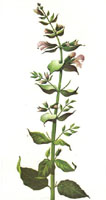View crop
View crop Data sheet EcoPortSalvia sclarea
 |
|
| Notes |
|---|
| BRIEF DESCRIPTION An erect herbaceous plant reaching a height of 1-1.5 m including the 40-60 cam long inflorescence. The rosette leaves are 10-20 cm wide. The flowers are pink, purplish-pink, or white. USES The leaves are a source of an aromatic oil, oil of clary, used in soaps, creams, powders, perfumes, and lotion, Fresh and dried leaves are used in flavoring in wines and medicines. Flowers are used in herbal teas, sachets, potpourris, and beverages. It is also planted as an ornamental. KILLING T Weak plants are frequently killed by frost, but most plants will in the rosette stage survive an average winter in Central Europe. GROWING PERIOD Biennial or perennial, that can be harvested twice in the second and third year. COMMON NAMES Clary sage, Clary wort, Clary, Clear eye, Eyelright, Muscatel sage. FURTHER INF Clary sage is indigenous to the costal area of the Mediterranean in both Europe and Africa. The crop takes up 1.78 kg of N, 0.29 kg of P2O5 and 2.37 kg of K2O from the soil for the development of 100 kg of inflorescence. Average yield 6-12 t/ha of fresh inflorescence, from which 7-15 kg/ha of essential oil can be distilled. | Sources |
| SOURCES (S. sclarea L.) Roecklein J 1987 pp 88 [USE, DRA, PH, RAIN] Prakash V 1990 pp 83 [USE] Duke J 1979 pp 107 [PH, RAIN, TEMP] Duke J 1975 pp 26 [PH, RAIN, TEMP] Hornok L 1992 pp 206-210 [DRA, DEP, LIG, TEMP, KTMP, TEXT, USE] |